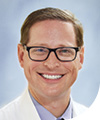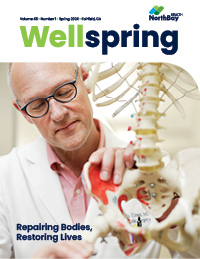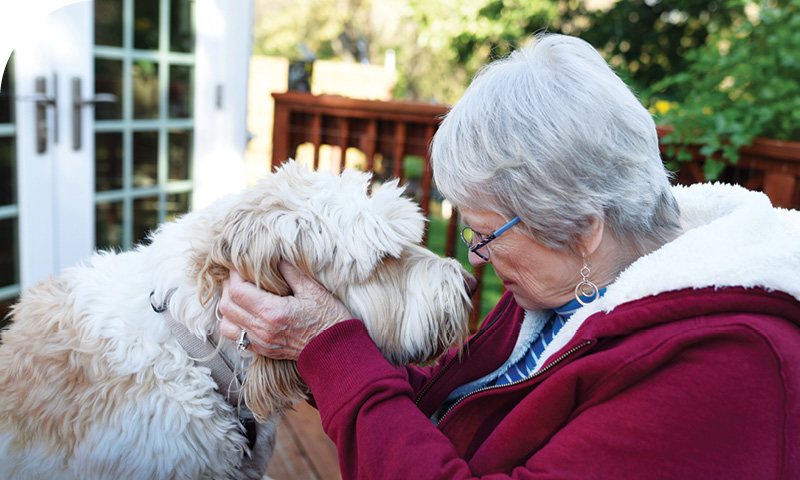
Patient Gets an ’Edge’ After Surgery
Not Too Old for Spinal Reconfiguration
Judith Neima enjoyed working side by side with her husband, Ted, in their Clipper Cargo store in downtown Vacaville until the pain her back pain grew so intense, she had to quit.
“Basically my lumbar discs had gone all cattywampus,” she recalled. “They were all out of alignment and, as a result, my nerves were being crunched and scrunched and ground.”
As she aged, she developed scoliosis, and although her medical care team tried a variety of approaches to relieve the pain, eventually it became clear she needed surgery.
That’s when she met neurosurgeon Patrick Maloney, M.D., who told her she would be one of the first NorthBay Health patients to benefit by having her spinal deformity corrected. During her appointments, Judith learned about the risks and benefits of addressing adult spinal deformity at her age. She was apprehensive, because she assumed that she was too old, at age 82, to undergo the surgery and had been told in the past that her spine “could not be fixed.”
“Low-dose imaging is a safer option because patients spend less time in an X-ray machine and they are exposed to less radiation. It’s just one shot and the images are obtained.”
Patrick Maloney, M.D., Neurosurgeon
She ultimately decided the pros outweighed the cons and had surgery in April 2023. Dr. Maloney removed the discs from her lumbar region, replaced them with cages, made multiple cuts in the spine to provide laxity and directed bone removal from the spine to loosen and manipulate it. He then installed a custom Cobalt-Chrome rod that runs from the base of her spine to the top of her abdomen.
She spent a few days in the Intensive Care Unit at NorthBay Health Medical Center before moving to a regular patient bed. Then it was off to a rehabilitation facility for four weeks.
“I walked the day after my surgery,” she recalls. “Everyone was amazed by that.”
But a few days later, she had a setback.
“Apparently the signals from my brain weren’t getting through to my right leg,” she said. So her rehab focused on learning to use her leg again.
“Time was my friend,” she said. “Time and exercise fixed the signals from brain to muscles.
After her surgery, she benefited from another advanced technology at NorthBay Health: A high-tech system called the EOSedge. It’s a low-dose 3-D full-body radiologic imaging system, which takes up a whole room on the first floor of the NorthBay Health Plaza.
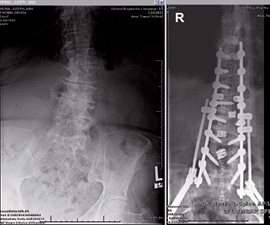
“This system stands alone as the most user-friendly technology available for total weight-bearing spine and leg,” said Chris Hayman, Director of Solano Diagnostic Imaging. “The importance of this is you get images with the full weight of your body on your back and joints. A regular X-ray has its place, but the images are usually taken with the patient lying down. When the patient is standing, it provides a more accurate picture.”
Although there are older generations of this technology available in California, only NorthBay Health and a location in Newport Beach have the most up-to-date system, which includes upgraded software for bone detail, noted Chris.
For Judith, it made getting X-rays a breeze. Recovering from surgery, she didn’t relish the idea of crawling on a table and having to maintain an uncomfortable position during the session.
“It was easy,” she said. “It’s like a phone booth. You step inside and stand stationary and then a moving X-ray travels up and down, controlled from the outside by the technician. It takes images from the front and side,” she recalled. “Nothing to it.”
For Dr. Maloney, the quality of the images made a world of difference.
“It’s a real game-changer,” he said. “It produces high quality images that offer the physician a more complete and accurate measurement of skeletal and spinal alignment. It allows me to create and execute a customized plan for complex spinal surgery.”
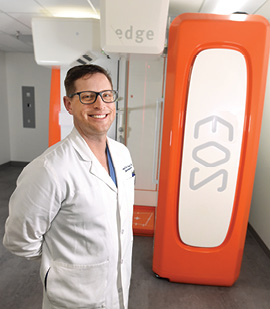
It’s also better for the patient.
“Low-dose imaging is a safer option because patients spend less time in an X-ray machine and they are exposed to less radiation,” said Dr. Maloney. “It’s just one shot and the images are obtained. The low-dose imaging was developed in the pediatric space, where reducing exposure to radiation for children is more critical than for adults.”
Judith, now 83, has recently completed physical therapy and is back to being able to drive, and enjoying time with her labradoodle named Lily. She’s also back to helping Ted in the store on occasion.
She’s thankful she was able to be one of the first to use the new EOSedge system, and wants to reassure others it’s a positive choice when one is in serious pain but needs X-rays.
In addition to being ideal for scoliosis patients, it will also be more gentle for those with severe osteoporosis and other spinal and musculoskeletal deficiencies.
According to Chris, cutting-edge technology like the EOSedge is usually found at large academic institutions and childrens’ hospitals.
“Not only does having the EOSedge offer a technological advantage for our surgeons, but the comfort it offers patients cannot be dismissed. This is an example of NorthBay Health putting our patients first.”
